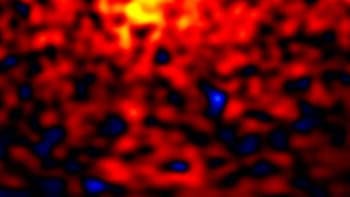
Physicists in Germany have found an alternative explanation for an anomaly that had previously been interpreted as potential evidence for a mysterious “dark force”. Originally spotted in ytterbium atoms, the anomaly turns out to have a more mundane cause. However, the investigation, which involved high-precision measurements of shifts in ytterbium’s energy levels and the mass ratios of its isotopes, could help us better understand the structure of heavy atomic nuclei and the physics of neutron stars.
Isotopes are forms of an element that have the same number of protons and electrons, but different numbers of neutrons. These different numbers of neutrons produce shifts in the atom’s electronic energy levels. Measuring these so-called isotope shifts is therefore a way of probing the interactions between electrons and neutrons.
In 2020, a team of physicists at the Massachusetts Institute of Technology (MIT) in the US observed an unexpected deviation in the isotope shift of ytterbium. One possible explanation for this deviation was the existence of a new “dark force” that would interact with both ordinary, visible matter and dark matter via hypothetical new force-carrying particles (bosons).
Although dark matter is thought to make up about 85 percent of the universe’s total matter, and its presence can be inferred from the way light bends as it travels towards us from distant galaxies, it has never been detected directly. Evidence for a new, fifth force (in addition to the known strong, weak, electromagnetic and gravitational forces) that acts between ordinary and dark matter would therefore be very exciting.
A team led by Tanja Mehlstäubler from the Physikalisch-Technische Bundesanstalt (PTB) in Braunschweig and Klaus Blaum from the Max Planck Institute for Nuclear Physics (MPIK) in Heidelberg has now confirmed that the anomaly is real. However, the PTB-MPIK researchers say it does not stem from a dark force. Instead, it arises from the way the nuclear structure of ytterbium isotopes deforms as more neutrons are added.
Measuring ytterbium isotope shifts and atomic masses
Mehlstäubler, Blaum and colleagues came to this conclusion after measuring shifts in the atomic energy levels of five different ytterbium isotopes: 168,170,172,174,176Yb. They did this by trapping ions of these isotopes in an ion trap at the PTB and then using an ultrastable laser to drive certain electronic transitions. This allowed them to pin down the frequencies of specific transitions (2S1/2→2D5/2 and 2S1/2→2F7/2) with a precision of 4 ×10−9, the highest to date.
They also measured the atomic masses of the ytterbium isotopes by trapping individual highly-charged Yb42+ ytterbium ions in the cryogenic PENTATRAP Penning trap mass spectrometer at the MPIK. In the strong magnetic field of this trap, team member and study lead author Menno Door explains, the ions are bound to follow a circular orbit. “We measure the rotational frequency of this orbit by amplifying the miniscule inducted current in surrounding electrodes,” he says. “The measured frequencies allowed us to very precisely determine the related mass ratios of the various isotopes with a precision of 4 ×10−12.”
From these data, the researchers were able to extract new parameters that describe how the ytterbium nucleus deforms. To back up their findings, a group at TU Darmstadt led by Achim Schwenk simulated the ytterbium nuclei on large supercomputers, calculating their structure from first principles based on our current understanding of the strong and electromagnetic interactions. “These calculations confirmed that the leading signal we measured was due to the evolving nuclear structure of ytterbium isotopes, not a new fifth force,” says team member Matthias Heinz.

Nuclear shape transitions visualized for the first time
“Our work complements a growing body of research that aims to place constraints on a possible new interaction between electrons and neutrons,” team member Chih-Han Yeh tells Physics World. “In our work, the unprecedented precision of our experiments refined existing constraints.”
The researchers say they would now like to measure other isotopes of ytterbium, including rare isotopes with high or low neutron numbers. “Doing this would allow us to control for uncertain ‘higher-order’ nuclear structure effects and further improve the constraints on possible new physics,” says team member Fiona Kirk.
Door adds that isotope chains of other elements such as calcium, tin and strontium would also be worth investigating. “These studies would allow to further test our understanding of nuclear structure and neutron-rich matter, and with this understanding allow us to probe for possible new physics again,” he says.
The work is detailed in Physical Review Letters.



